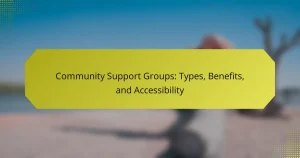Peer support programs provide essential emotional support and foster community among individuals facing similar challenges. This article explores their structure, highlighting the importance of trained facilitators and defined goals. It also examines the benefits participants experience, such as improved mental health outcomes and resilience. Finally, best practices for implementing effective peer support programs are discussed, addressing common challenges and emphasizing the need for ongoing evaluation.
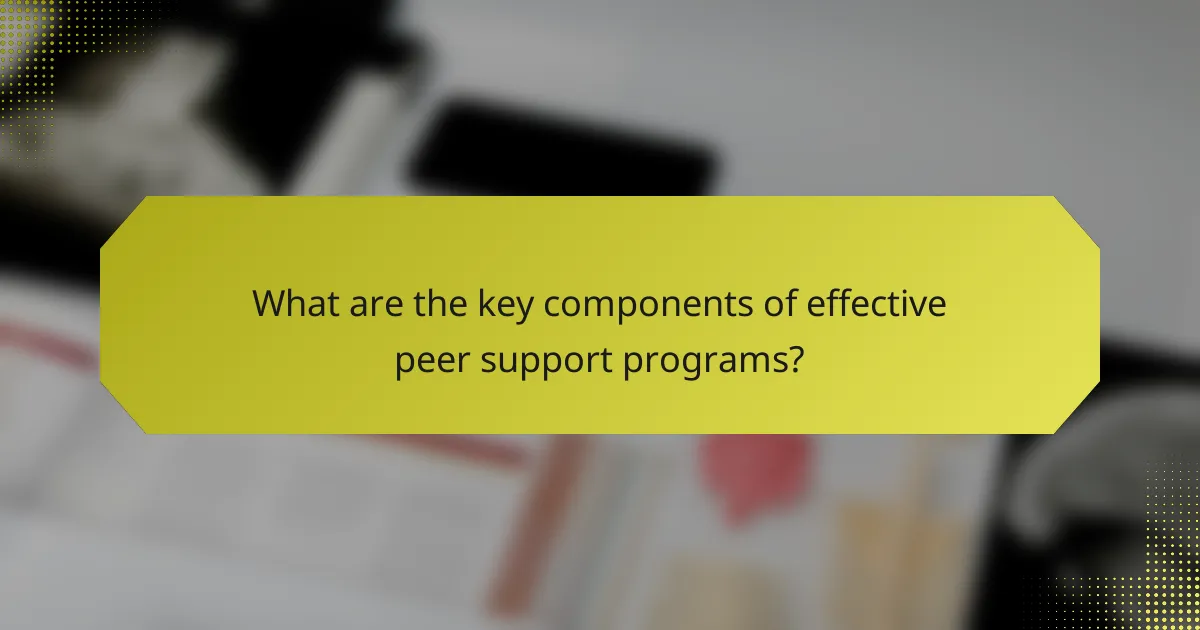
What are the key components of effective peer support programs?
Effective peer support programs include trained facilitators, clear structure, defined goals, and ongoing evaluation. These components ensure participants receive consistent guidance and support. Trained facilitators enhance trust and rapport, while a clear structure provides a framework for interaction. Defined goals help measure success and outcomes. Ongoing evaluation allows for program adjustments based on participant feedback and effectiveness.
How do peer support programs typically operate?
Peer support programs typically operate by connecting individuals with shared experiences to provide emotional and practical assistance. These programs often include structured meetings, training for peer supporters, and guidelines to ensure effective communication.
Participants engage in various activities such as group discussions, one-on-one support, and skill-building workshops. The main benefits include increased resilience, improved mental health, and a sense of community. Best practices emphasize confidentiality, active listening, and ongoing training to enhance the effectiveness of peer support.
What roles do facilitators play in peer support programs?
Facilitators in peer support programs foster connections, guide discussions, and ensure a safe environment. They play crucial roles in training, conflict resolution, and maintaining group dynamics. Effective facilitators enhance participant engagement and promote shared learning experiences. Their unique attribute lies in their ability to adapt to diverse group needs, creating tailored support strategies.
What are the common structures of peer support programs?
Peer support programs typically feature structured frameworks that promote shared experiences and mutual assistance. Common structures include group meetings, one-on-one sessions, and online forums. These formats facilitate connection, emotional support, and resource sharing among participants. Additionally, program design often incorporates training for peer supporters to ensure effective communication and guidance.
How are peer support groups organized?
Peer support groups are typically organized around shared experiences and goals among participants. They often include a facilitator, a structured meeting format, and guidelines to ensure a safe environment. Groups may vary in size, duration, and focus, such as mental health, addiction recovery, or chronic illness support. Effective groups prioritize inclusivity, confidentiality, and mutual respect, fostering a sense of community and belonging.
What types of peer support formats exist?
Peer support programs exist in various formats, each designed to facilitate connection and support among individuals. Common types include one-on-one support, group support, online forums, peer-led workshops, and community events. These formats cater to diverse needs, promoting sharing and understanding.
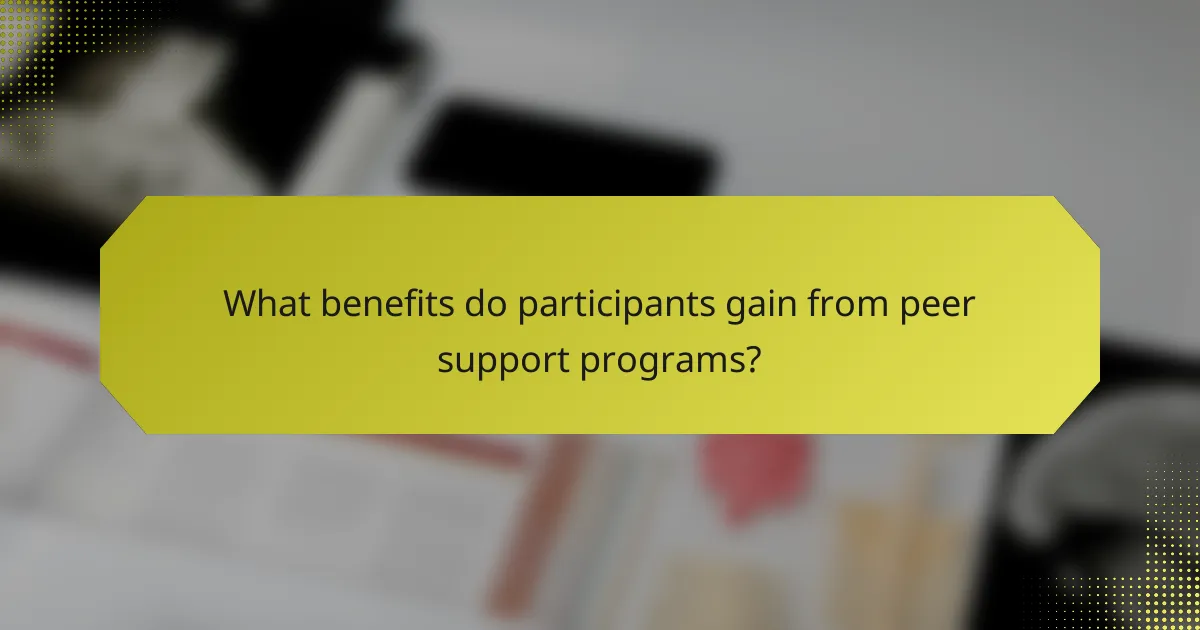
What benefits do participants gain from peer support programs?
Participants in peer support programs gain emotional support, enhanced coping skills, and a sense of community. These programs foster connection, reduce feelings of isolation, and promote personal growth. Evidence shows that participants experience improved mental health outcomes and increased resilience. As a result, peer support programs can significantly impact individuals facing similar challenges.
How do peer support programs enhance emotional well-being?
Peer support programs significantly enhance emotional well-being by fostering connections among participants. They provide a safe space for sharing experiences and feelings, leading to increased empathy and understanding. Participants often report improved self-esteem and reduced feelings of isolation. Evidence shows that these programs can lower anxiety and depression levels, promoting overall mental health. Additionally, they empower individuals by encouraging personal growth and resilience through shared learning experiences.
What skills do participants develop through peer support?
Participants in peer support programs develop skills such as communication, empathy, problem-solving, and active listening. These skills enhance personal growth and foster community connections. Additionally, participants often gain leadership abilities through facilitating discussions and supporting others. Overall, peer support cultivates a collaborative environment that strengthens interpersonal skills and promotes emotional resilience.
How do peer support programs foster community and belonging?
Peer support programs foster community and belonging by creating safe spaces for individuals to connect and share experiences. These programs enhance social networks, reduce feelings of isolation, and promote empathy among participants. A study showed that 70% of participants felt an increased sense of belonging after engaging in peer support. Additionally, unique attributes of these programs, such as shared lived experiences, facilitate deeper connections and understanding. As a result, individuals often report improved mental health and overall well-being.

What unique features distinguish successful peer support programs?
Successful peer support programs are distinguished by their structured approach, shared experiences, and accessibility. Key features include trained facilitators who guide discussions, a focus on mutual aid rather than professional advice, and a safe, non-judgmental environment. These programs often incorporate diverse formats, such as one-on-one sessions or group meetings, to cater to different needs. Unique attributes like participant feedback loops and adaptability to community-specific challenges further enhance their effectiveness.
How does cultural context influence peer support effectiveness?
Cultural context significantly impacts the effectiveness of peer support programs. It shapes communication styles, trust levels, and the perceived value of support.
Cultural norms dictate how individuals express vulnerability and seek help. For instance, collectivist cultures may emphasize community support, enhancing program engagement. In contrast, individualistic cultures may prioritize personal autonomy, affecting participation levels.
Language barriers can also hinder the effectiveness of peer support. Programs must consider linguistic diversity to ensure inclusivity. Tailoring support to align with cultural values fosters a sense of belonging and increases program success.
Finally, understanding cultural stigma surrounding mental health can improve outreach strategies. Programs that acknowledge and address these stigmas are more likely to resonate with participants, leading to better outcomes.
What innovative approaches are being used in peer support?
Innovative approaches in peer support include technology integration, tailored programs, and community involvement. Virtual platforms enable real-time connections, enhancing accessibility. Customized training ensures peer supporters address specific needs effectively. Collaborative efforts with local organizations foster a supportive environment, promoting wider outreach and engagement. These strategies enhance the overall effectiveness of peer support programs.
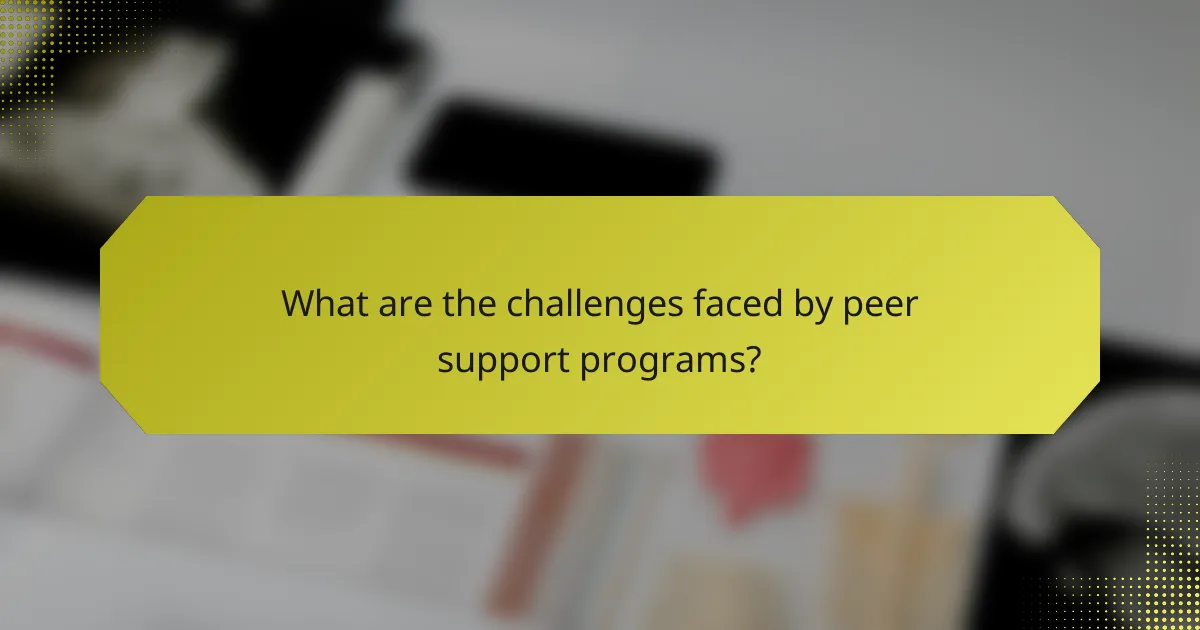
What are the challenges faced by peer support programs?
Peer support programs face several challenges that can hinder their effectiveness. These include inconsistent participation levels, varying degrees of training among peer supporters, and difficulties in maintaining program funding. Additionally, measuring the impact of these programs can be complex due to subjective experiences. Addressing these challenges is crucial for enhancing the overall success and sustainability of peer support initiatives.
What limitations do peer support programs encounter?
Peer support programs often face challenges such as funding limitations, participant engagement, and varying levels of training among facilitators. These issues can hinder the effectiveness and sustainability of the programs. Additionally, stigma surrounding mental health may prevent individuals from seeking support. As a result, addressing these limitations is crucial for enhancing program impact.
How can peer support programs address participant diversity?
Peer support programs can effectively address participant diversity by fostering inclusive environments. They encourage varied perspectives, enhancing the support experience for all participants. Tailored training for facilitators on cultural competence ensures sensitivity to diverse backgrounds. Additionally, diverse peer groups promote relatability, which strengthens connections and engagement. Programs that incorporate feedback mechanisms can adapt to the unique needs of participants, further enhancing inclusivity.
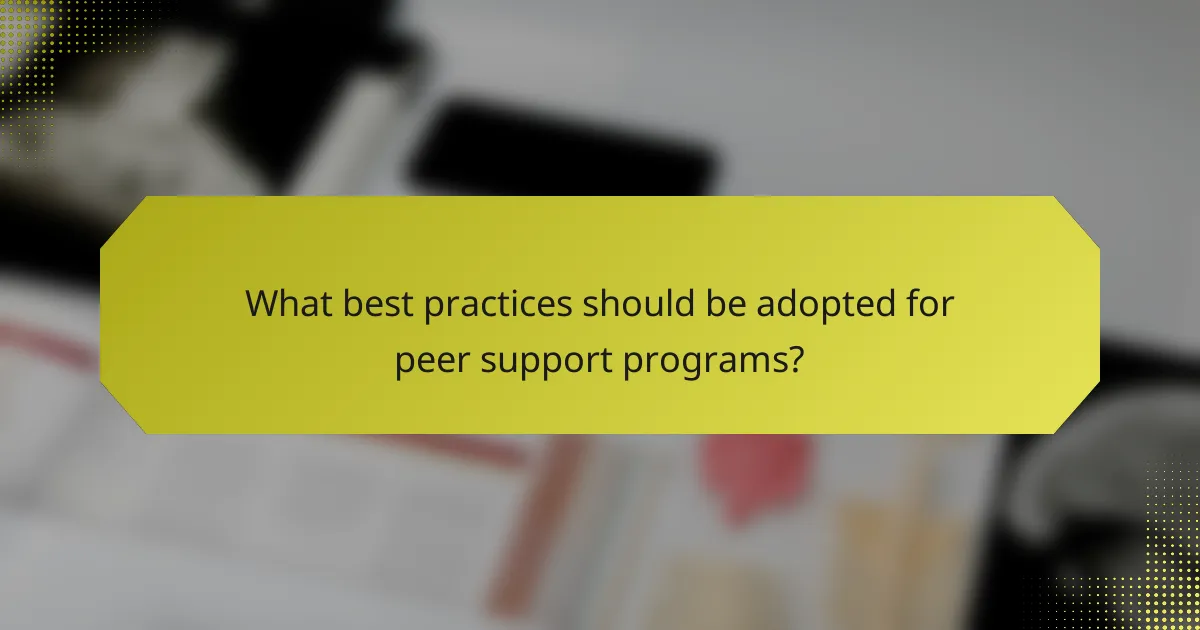
What best practices should be adopted for peer support programs?
Peer support programs should prioritize clear structure, effective training, and ongoing evaluation. Establish a defined framework that includes roles, responsibilities, and guidelines. Train peers thoroughly to ensure they can provide support effectively and empathetically. Regularly assess program outcomes to identify areas for improvement and adapt accordingly.
How can peer support programs be optimized for engagement?
To optimize peer support programs for engagement, focus on fostering a sense of community and inclusivity. Implement regular training for peer supporters to enhance their skills and confidence. Utilize technology, such as apps or online platforms, to facilitate communication and resource sharing among participants. Collect feedback frequently to adapt the program to meet evolving needs and preferences. Finally, recognize and celebrate participant achievements to reinforce commitment and motivation.
What common mistakes should be avoided in peer support initiatives?
Common mistakes in peer support initiatives include lack of training for peer supporters, insufficient program structure, neglecting participant feedback, and failing to establish clear boundaries. These oversights can hinder effectiveness and lead to burnout among supporters. Ensuring proper training and clear communication can enhance program success.
What expert insights can improve peer support program effectiveness?
Effective peer support programs can be enhanced by incorporating structured training, regular feedback, and clear communication channels. Training equips peers with necessary skills and knowledge. Regular feedback fosters continuous improvement, while clear communication ensures alignment among participants. Research shows that programs with these elements report higher satisfaction and better outcomes.

